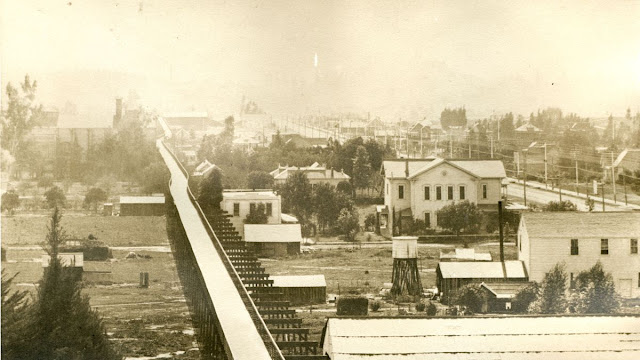The California Cycleway: A Tollway For Bikes
The California Cycleway was an elevated bicycle path in Pasadena, California., and was a short-lived, tolled, “bike highway”, not unlike the linear parks of today, minus the tolls at least. It first opened in 1900, and was planned to run nine miles in length between Los Angeles and Pasadena, CA.
Despite its failure, the Cycleway would inspire future highway design, and was an early example of grade separation between pedestrian traffic and automobiles and trains.
 |
| California Cycleway looking south from Hotel Green, c.1900 |
Its 15 cent toll was too high to attract riders, but too low to fund more than 1.4 miles of construction, of what was a 9 mile proposal, which included a never built casino at one end. The cycleway was financed entirely by private parties, unlike road projects of today. Although the project received a great deal of attention and support from the public, it was ultimately never completed. The California Cycleway was plagued by financial difficulties, and a lack of government support, and it was eventually abandoned in the early 1900s.
The cycleway was to be elevated above the street and would have been approximately 8 feet (2.4 meters) wide, with the right of way being at least 100 feet (30.5 meters) in width. The elevated path would have been supported by a series of posts and beams, and would have included bridges, viaducts, and ramps to connect to the street level, much like Chicago's "606" Trail, just 100 years beforehand.
While the idea sounds far-fetched by today's standards, the world was a much different place in 1908, and no one knew for sure if cars were going to be the way of the future.
Historian Peter Norton discussed the parkway with Business Insider, "Many experts and ordinary people agreed that cars didn't really belong in cities," he said. "They made a lot of sense in the country, but in the city, they demanded too much space, drove pedestrians off the streets, and injured too many people." Of course, in the recent decade, people are beginning to re-think vehicle-centric cities and suburbs in favor of transit-oriented design and active transportation.
The cycleway closely followed the present day route of the Arroyo-Seco Parkway, or CA-110. One could consider the California Cycleway a predecessor to the movement for modern roads in the early 20th century, which truly began with the Long Island Motor Parkway in 1908, on the complete opposite end of the United States.
Thanks as always for reading!




Comments
Post a Comment